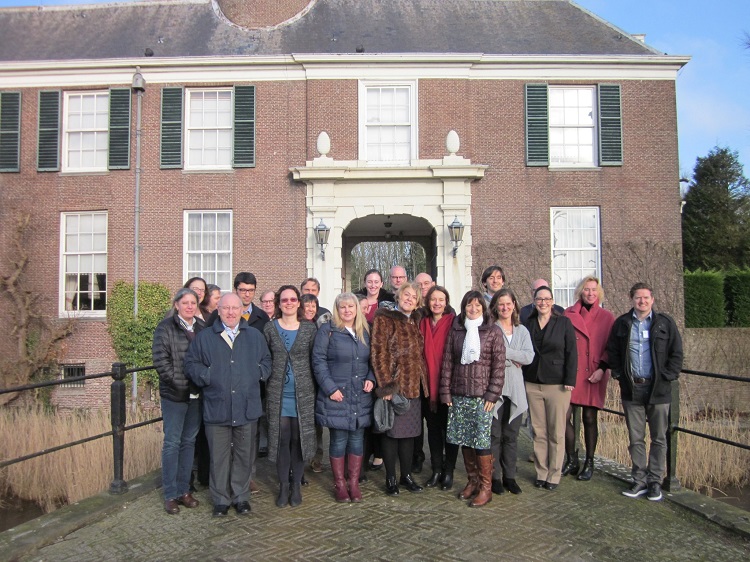Towards validated and qualified biomarkers for therapy development for Duchenne Muscular Dystrophy
- Number 226
- Date 30 January 2017
This workshop was supported by:

![]()
Dutch translation
German translation
Italian translation
Swedish translation
Lay Summary
Biomarkers are substances in our body that can be measured, and that relate to
- The presence of a disease, and this is referred to as a diagnostic biomarker. For example, elevated CK (creatine kinase) in the blood indicates muscle damage and is a diagnostic biomarker for Duchenne but also for other muscle diseases.
- The disease course, and this is referred to as a prognostic biomarker. Dystrophin is absent for Duchenne patients and altered for Becker patients, and this is considered a prognostic biomarker.
- Whether a therapy is having an effect, and this is called a pharmacodynamic biomarker. Detecting dystrophin for a therapy aiming at dystrophin restoration is a pharmacodynamics biomarker. Pharmacodynamic biomarkers can also be used to assess the safety of a therapy, e.g. increased levels of liver enzymes in the blood can be a sign of liver damage induced by the therapy.
The workshop focused on pharmacodynamic biomarkers, and discussed the importance of “context of use”, the purpose of the biomarker. For example, muscle biopsy to detect dystrophin is being used in clinical trials as a pharmacodynamic biomarker in the context of finding the optimal drug dose. Furthermore, pharmacodynamic biomarkers are being used in DMD trials in the context of monitoring safety and side effects with blood samples. As research uncovers new biomarkers in DMD patients in blood and urine, these become candidates for new uses in future clinical trials as markers of either safety or efficacy.
Sometimes biomarkers can also be used as a primary outcome measure in clinical trials instead of functional outcome measures such as the 6 minute walk test and these are considered surrogate endpoints. In Europe biomarkers can only be used as surrogate endpoints after going through a rigorous regulatory process to officially qualify them for this purpose. Similar pathways exist in the USA.
There are no qualified biomarkers for Duchenne muscular dystrophy at the moment. However, in the 204th ENMC workshop on DMD biomarkers, two markers (dystrophin and magnetic resonance imaging (MRI)) were identified as candidates for the qualification process. In parallel work has been ongoing to identify additional biomarkers in serum and urine. For this work serum and urine samples are required from patients and controls, and are preferred because they are less invasive than having a muscle biopsy.
The aims of this follow up workshop were
- To discuss dystrophin and skeletal muscle MRI as biomarkers to be able to prioritize and align the work that still needs to be done.
- To compare the biomarkers detected in blood and urine to select the most suitable candidates and discuss future tests to confirm their usefulness
- To set up a way for collecting, storing and sharing blood and urine for biomarker identification and validation
During the workshop it became clear that for MRI much of the gaps identified in the previous workshop (204th ENMC workshop, 2014) have now been filled. Alignment was reached on a proposed path for qualifying MRI and dystrophin quantification with the regulatory agencies. For MRI, current efforts are focused on showing responsiveness of the biomarker to drugs in human trials.
Furthermore, there was consensus on what criteria new candidate biomarkers need to fulfill. Biomarkers need to be specific, reproducible, reliable and robust. Ideally markers found in animal models need to be also confirmed in humans, markers need to be responsive to drug treatment in animal models, and, ideally markers need to be measurable in easily accessed samples (urine, saliva and blood).
Finally, the group agreed that a virtual biobank is needed, and that this can be achieved using existing platforms such as Eurobiobank (www.eurobiobank.org) and BB-MRI ((Biobanking and Biomolecular Resources Research Infrastructure, www.bbmri.eu)). It is important to identify existing samples, and for the collection of future samples standardized procedures should be used. An oversight committee is required, ideally following the TACT (TREAT-NMD advisory committee for therapeutics, www.treat-nmd.eu/tact) model, with a small core group with equal representation of patient representatives, academics and industry, and a larger extended group for expertise. The management part of this biobank should be funded by patient organisations and industry. Efforts will be undertaken to initiate this committee in a timely fashion.
The three-day workshop (January 20-22, 2017) supported by the European Neuromuscular Center (ENMC) and Marathon Pharmaceuticals, involved academics, industries and patient advocacy groups from the US, UK, Germany, Italy, Sweden and the Netherlands.
A full report is published in Neuromuscular Disorders (pdf)

